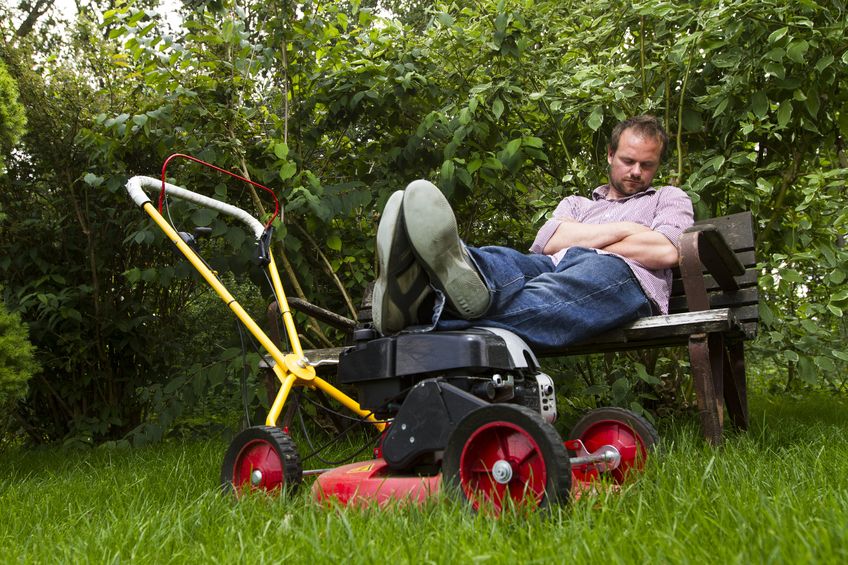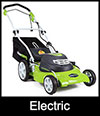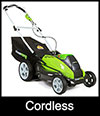There are many questions that come up when you’re thinking of buying a new lawn mower whether it’s to replace your old model or choosing your first one. One of the biggest questions asked is which type to get: Gas, electric or Cordless? While each have their pros, they also each come with a list of shortcomings. At the end of the day, which type you select is going to depend on your lawn, your lifestyle and which one you will enjoy using the most. With that in mind, let’s dive right in…
Pros
Gas
- Cut through tough and tall grass
- No cord to worry about
- No waiting for the battery to charge
- Usually more durable than electric / cordless models
- No chance of electrocution
Electric & Cordless
- Require less maintenance
- Environmentally friendly
- Quiet compared to gas models
- More cost effective in the long run
Cons
Gas
- Loud
- Continuing costs for fuel, oil, filters, spark plugs
- More maintenance required
Electric & Cordless
- Limited mobility
- May not do as well on thick or tall grass
- Cordless have limited run time
- Need to keep them dry
- More expensive to buy
Comparing Noise
Gas mowers have a decibel level of about 106, whereas electric and cordless models are very quiet by comparison. Since decibel levels over 85 can potentially lead to hearing loss, quiet in this case is much appreciated. Also, you don’t risk waking the neighbors if you’re out cutting grass at 7am.
Environmental Concerns
Obviously electric and cordless mowers are more environmentally friendly since, just like electric cars, they don’t have the emissions of gas-powered motors. Of course, just like with car batteries, there is the concern with cordless mowers of how long it takes the batteries to decompose after they die. This issue remains up for debate, with the anti-combustion engine crowd running at the forefront for the most part.
Fuel Economy
In general, the cost of gas mowers is a little bit cheaper with electric or cordless, but what about operating costs over time? According to studies, an electric model can mow approximately a third of an acre on a charge. Of course, this depends on the heartiness of your battery as well as other factors. If a typical push mower takes 3.5 KW to recharge, then it likely costs about $.38 every time you recharge the battery.
Comparably, it’s estimated you can mow about 0.5 acres on one tank of gas, and the tanks hold about 2/3 of a gallon. Depending on the current price of gas, you can expect to spend about $2.00 to mow this amount of yard.
With all this said, in the long run, electric and cordless models will cost you less over time. However, keep in mind that if you have a cordless mower, the batteries will eventually need to be replaced. Most manufacturers offer a 2-year warranty on batteries and chargers, but after that – you’re on your own. This can be an important for some when choosing between a gas vs battery lawn mower.
Power
Without a doubt, most gasoline mowers outperform their cordless and electric counterparts. However, with newer technology making its debut, many of the newer non-gas models are giving the gas hogs a run for their money. While gas machines tend to overall do better on really tough, thick grass or even long weeds, the others are catching up fast. And let’s face it – if your yard is that bad, you’ll be better off renting a bush hog than going at it with any lawn mower.
While gas lawn mowers often (but not always) offer more power, you do have to mess with gas and oil. You have to remember to buy it and have a safe place to store it. For people with garages, this is usually no big deal. However, if you live in a home without a garage or even a small condo or house without a basement, it’s hard to figure out how to deal with these toxic (and flammable) chemicals.
Storing Gas
According to the National Ag Safety Database (and its mostly common knowledge), gasoline needs to be stored in the proper type of container for safety. It shouldn’t be hauled or stored in an old milk jug, glass container or any container that’s been used for some other type of fluid. It can contaminate the fuel, and furthermore, depending on the prior use of the container, it could cause an unwanted chemical reaction or even a fire.
Even some old approved gas cans can be dangerous, as the plastic ones can become brittle as they age. They can also become sensitive to temperature changes over time. Also, some cans cannot be sealed well enough to prevent possible spillage.
The best containers to use to store gasoline are approved by FM (Factory Mutual) and UL (Underwriters Laboratories). They come in several different sizes and have different valve types for pouring the liquid. You can even add a funneled spout to reduce spills when pouring. While these containers do cost more than some cheaply-made ones that are available, it’s worth the extra cost. Not only are they safer, they’ll outlast several of the less expensive types.
While the container is important, where you store it is just as vital. If you store it improperly, you can risk a fire or even an explosion in or around your home or vehicle. While gasoline is not something that should instill fear, it should be treated with a healthy respect as it is a highly volatile liquid. In fact, if it’s mixed with just the right (or wrong) proportion of air, the vapors from just one cup of gas have the explosive power of approximately five pounds of dynamite, more than enough to cause a great deal of destruction.
Storing Your Gas Mower
As for storing your gas-powered mower, be careful to keep all four wheels on the ground to avoid any types of spills or leaks. After that, each manufacturer sets their own instructions on the best way to store your mower for the winter, so definitely pay attention and adhere to those so you don’t void the warranty.
Some manufacturers suggest draining the fuel and oil tanks once the grass cutting season is over. This makes the machine safer to store and also avoids the chance of water getting condensed in with the other fluids, which can cause running problems. Keep in mind when you refill it in the spring, it might take a little longer to start, as the fluids have to make their way through the system.
There are pluses and minuses to draining the fuel and oil, however. Some say that draining the fuel lets oxygen into the carburetor, which can cause it to gum up and varnish. Since you’ll never get every drop of gas out, debris can settle in spots like the needle valve tip. If this happens, you’ll need to clean the carburetor before the mower will start.
There’s also some buzz that letting the gas tank sit empty lets water vapor accumulate which can cause corrosion in the fuel lines, carburetor and cylinders and even in the gas tank itself. “White Rust”, also known as wet storage stain, can be caused by this. White rust is a type of zinc corrosion on metal and is caused by metal exposed to a damp environment with limited carbon dioxide and oxygen.
Other manufacturers recommend using a fuel stabilizer rather than draining the tank. It is often recommended to start adding stabilizer to your fuel about one month before the end of the mowing season. Over the winter, the stabilizer will stop old fuel from degrading.
Run down the gas tank as much as you can the last time you cut the grass for the season. Then, fill the gas tank with at least 95% clean, stabilized fuel. This will reduce the risk of water vapor condensing in the tank and contaminating the fuel. After you fill up the tank, run the mower for a few minutes to disperse the stabilized fuel into the fuel lines and carburetor.
Another good thing to do is to replace the air filter, just like you would do in your car. This way, your mower will be clean and ready to use when the time comes. Replacing the spark plug, changing the oil and sharpening the blade(s) if needed will ensure your mower is ready to go in the spring when the grass is ready.
Storing Electric and Cordless Mowers
Storing these types of mowers is much less work and hassle overall. While you’d hose off a gas mower, it’s not a good idea to do this to clean off your electric or cordless model. Instead, after you’ve used it for the last time for the season, let it sit for a day or two to let any grass under the housing dry. Then, use a brush or old rag to wipe away any debris. If there’s a lot, it might be easier to start by giving it a good shake; letting most of it fall off.
Then, wipe down the housing or any dirty parts with a damp cloth. After it’s clean, if your mower has a battery, you’ll want to remove it and make sure it’s stored in a dry place for the winter.
As for ways to store your mower, some models can be stored vertically or horizontally, and many have a handle that folds down for a smaller footprint. In more than one user review, owners say they keep their machine hanging on the wall. If you decide to go this route, just make sure your hangers are secured into heavy wall studs that can support the weight of the mower.
The Final Say
Both cordless/electric and gas mowers can be a good deal depending on how you use them and how you need to use them. The bottom line is that a corded electric or cordless model with rechargeable batteries is the best idea if you have a smaller yard. If you get a cordless model with more than one battery, it’s easier to mow a larger yard without running out of juice, because you’ll always have a backup. Cordless and electric models are cleaner, quieter and overall easier to use and maintain, so they win in my book.
However, if you have a tough or large yard or standing water to mow through, you may be happier with a gas vs electric mower. While they’re heavier and bulkier as a general rule, there’s no doubt they’re tough. While they’re a bit of a pain to maintain, you won’t have to worry about charging batteries or a cord getting in the way.























